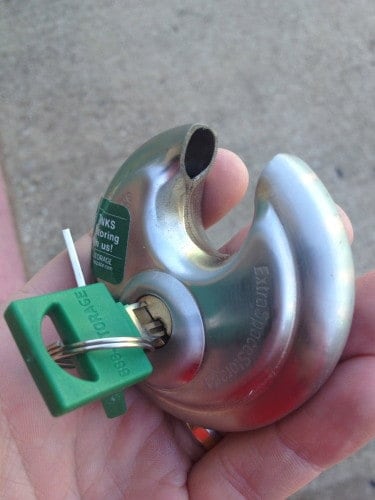In prep for our move to San Antonio, my wife and I have been applying “5S” principles to our lives and possessions. We have gone through an intense “sort” process – deciding what to move and what to donate or trash. Even with getting rid of many items that really just aren't needed (binders full of old college engineering homework, for example), we've decided to rent a local storage unit. Since we are buying a condo that's smaller than our house, we have some furniture that we might want in the future when we go back into a house the next time my wife gets transferred somewhere.
In this process, I was exposed to a new type of lock that has an an interesting error proofing feature…
This type of lock is called a “disc lock” and it's considered to be way more secure (harder to cut through) than your standard padlock.

The mistake proofing feature actually involves the key. It would be a big mistake to THINK you have locked your storage unit, only to drive off and realize that the lock wasn't fully engaged, leaving your stuff unsecured.
With this lock, you CANNOT remove the key unless the lock has been fully closed and engaged. Brilliant! You could drive off without locking the unit, but if you attempt to lock it, the only way you can take the key with you is if the unit is fully locked. So, as pictured, I would not be able to remove the key. Even better, there's a point in turning the key where you might think it is locked… but it's not. Hence, the error proofing is very helpful.
This is only a $15 lock. I think this proves that error proofing doesn't have to be expensive, it has to just be thoughtfully designed into a product.
Is there a lesson for healthcare and all of the technology and software that's NOT error proofed?
Please scroll down (or click) to post a comment. Connect with me on LinkedIn.
Let’s build a culture of continuous improvement and psychological safety—together. If you're a leader aiming for lasting change (not just more projects), I help organizations:
- Engage people at all levels in sustainable improvement
- Shift from fear of mistakes to learning from them
- Apply Lean thinking in practical, people-centered ways
Interested in coaching or a keynote talk? Let’s talk.
Join me for a Lean Healthcare Accelerator Trip to Japan! Learn More










Two slight corrections about ‘mistake proofing’:
1) “…way more secure” note really, perhaps slightly more secure in that a quick blow from a hammer would be thwarted, a big set of bolt cutters would make quick work of this padlock. Or someone who knew how to lock pick. Check out the lock picking and lock smith competitions, locks are designed to keep honest people honest (and some of the less motivated criminals).
http://www.wired.com/wired/archive/13.02/lockbusters.html
2) There is still a glaring possible mistake (I see it all too often with my kids and wife) and that is that you could leave the key in the lock. Now if that can be solved for it would go a long way to ‘mistake proofing’ the lock.
You’re right that the lock is not perfectly mistake proofed. It’s not 100% secure, as you point out. I could still leave the key in the lock. I could forget to attach to the lock to the door, either leaving it on the ground or taking it home with me.
To have a completely defect-free process might require a combination of technology and process (such as me having a checklist that I use to make sure I didn’t forget to attach the lock, etc).
Best mistake-proofing story in a healthcare institution recently was this: the hospital’s human factors engineer (yes, there was one!) vetoed a plan to install new IV smart pumps. Why? The keypad was “upside down” in relation to other keypad devices in use across the hospital. In other words, 1-2-3 started along the top row on the proposed new IV pumps, but other keypads in the place had 1-2-3 starting along the bottom row, like your calculator. She saw an accident waiting to happen and vetoed that purchase. Yaay, huh?
That’s awesome. Even on their own, some of these pumps tend to not be well designed to prevent errors (google “double key bounce” as an example of that poor design).
Glad to hear that they considered human factors to help prevent those errors that would have been just waiting to happen….
Place the Lock Key on your car key ring. This way you can’t leave without placing the lock on. Since the key won’t come out until it is locked. Then if you don’t lock the storage unit the lock will be hanging from your ignition. Or you can’t start your car if you leave the lock sitting somewhere or keys in the lock. This forces you to lock your storage unit or damage your ignition from the weight of the lock.
I used one of these on my Harley for years. I have seen them driven over, Attempted to cut with bolt cutters, Hit with hammers and other things but did not break. Now a grinder could cut it off but is noisy. Good choice of locks. Of course when I got mine they were about $60.
Yes, putting the key on the car’s key chain would another great example of mistake proofing.
I used these on a storage unit myself and I kept my key on my car’s keychain as well. Big fan of these locks – the vulnerable piece (bar/ring activating lock) is minimally exposed.
Comments are closed.